The following day started with rain, but as we were not in a hurry we allowed ourselves idle breakfast, sitting on the lovely terrace of our hotel in Hoi An. Just like the previous morning, we also had different Vietnamese specialties on offer. I enjoyed eating them, while Sneza did a great job photographing them.
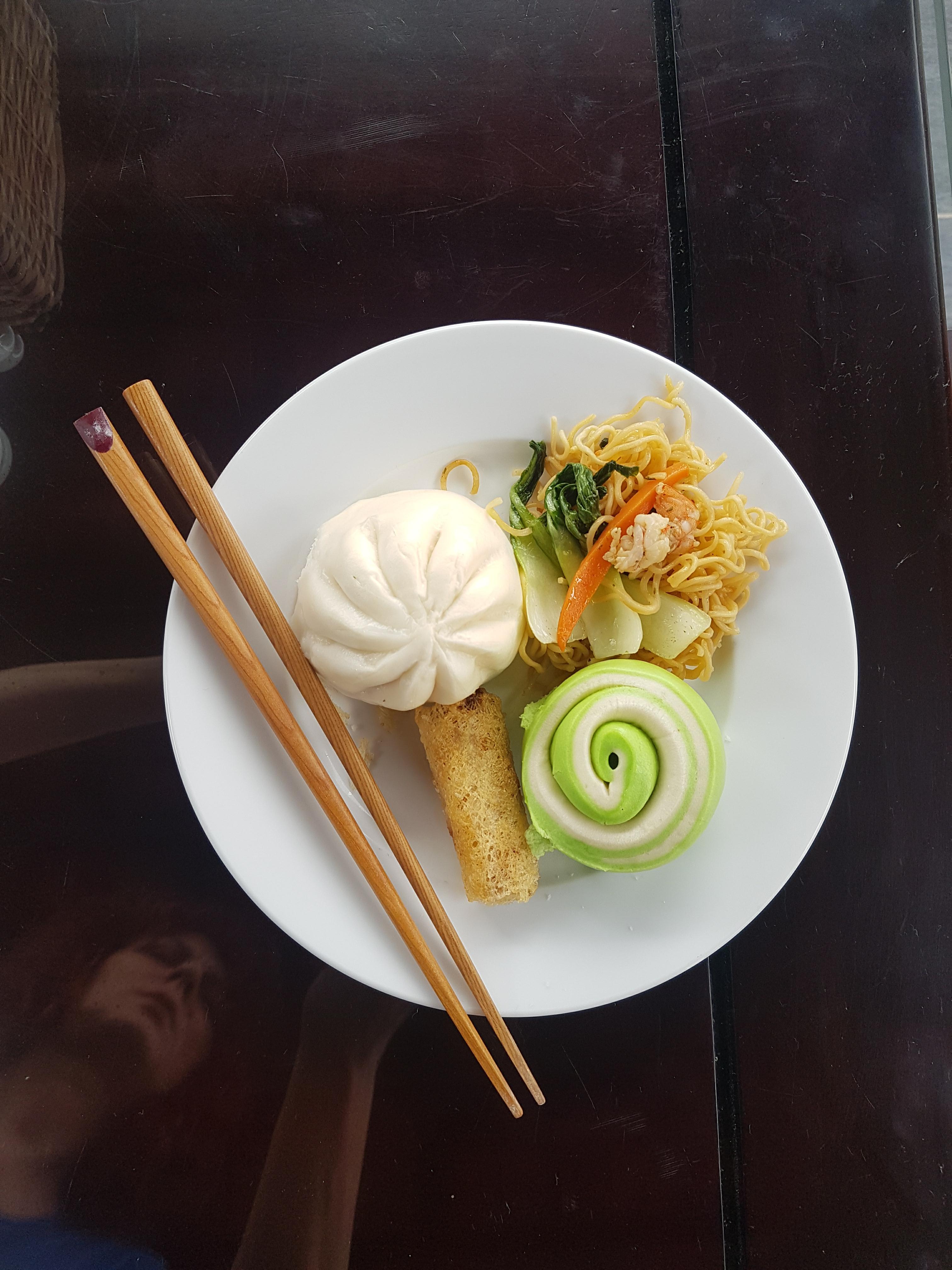 A part of my breakfast in Hoi An (Photograph courtesy of SM)
A part of my breakfast in Hoi An (Photograph courtesy of SM)
Still, the weather calmed down and we walked to the centre of Hoi An again with the plan to visit two more places for which we had those coupons. First we went to a private house where there is in fact the Tran Family Chapel and it was not crowded at all which made it rather interesting. A woman, I suppose one of the residents, told us a little bit about who had built the house and the chapel, and she also pointed out some architectural elements for us: the Chinese influence could be seen in the vaulted ceiling shaped in such a way as to resemble a turtle back, the Japanese influence which is reflected in triple pillars and beams that carry the load of the roof, while the rest was done in line with the Vietnamese vernacular masonry. The house was built at the beginning of the 19th century by Tran Tu, the main ancestor, who rose to the level of mandarin and was even sent to China as an ambassador. When you enter the house-chapel, you can see his picture on the right-hand side.
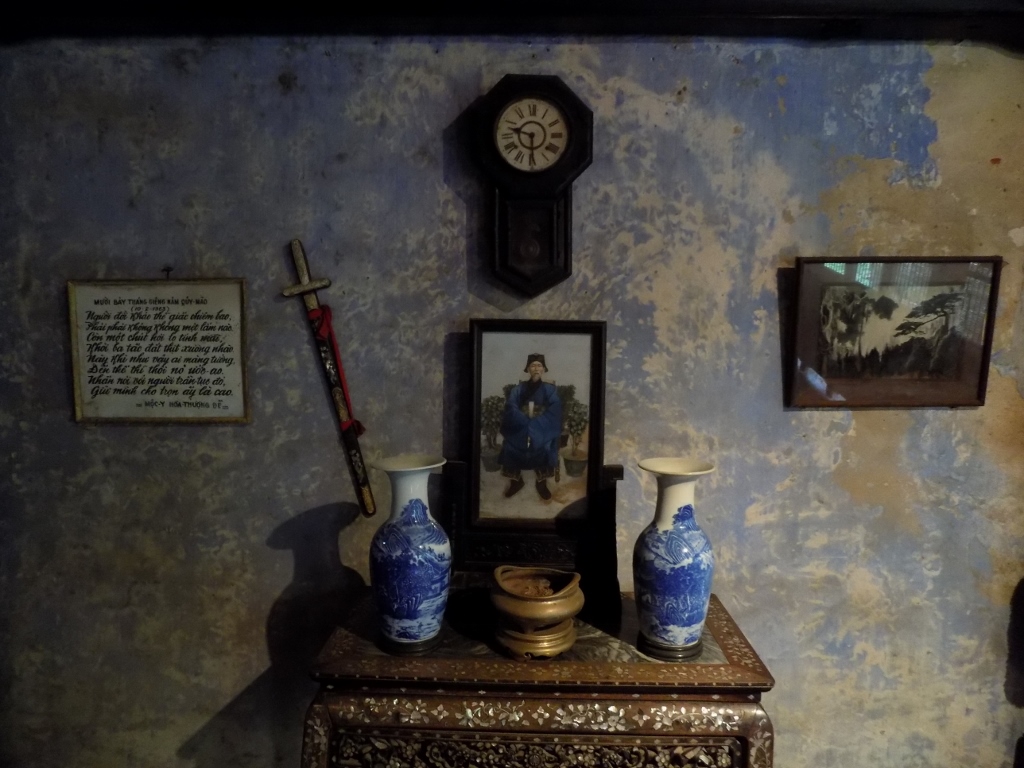 Picture of Tran Tu at the Tran Family Chapel
Picture of Tran Tu at the Tran Family Chapel
Then we walked around the house, came to the basically mandatory section full of souvenirs for sale and there I saw an incense-box which I really loved at first sight, so I bought it right away. I am generally a very practical person and with time I have stopped buying souvenirs, at least the classical ones. I possibly like to buy something which I need anyway, but which perhaps has some sign about being made in some particular place. On the other hand, with time (and hopefully with maturity, which would be great), I have come to a conclusion that I actually don’t need many things and therefore I don’t care even about practical souvenirs.
Afterwards we went again to a community space, that is, to the Cam Pho Communal House, of the Japanese origin, which was also very nice for it gave us at least a slight insight into the impacts of yet another culture.
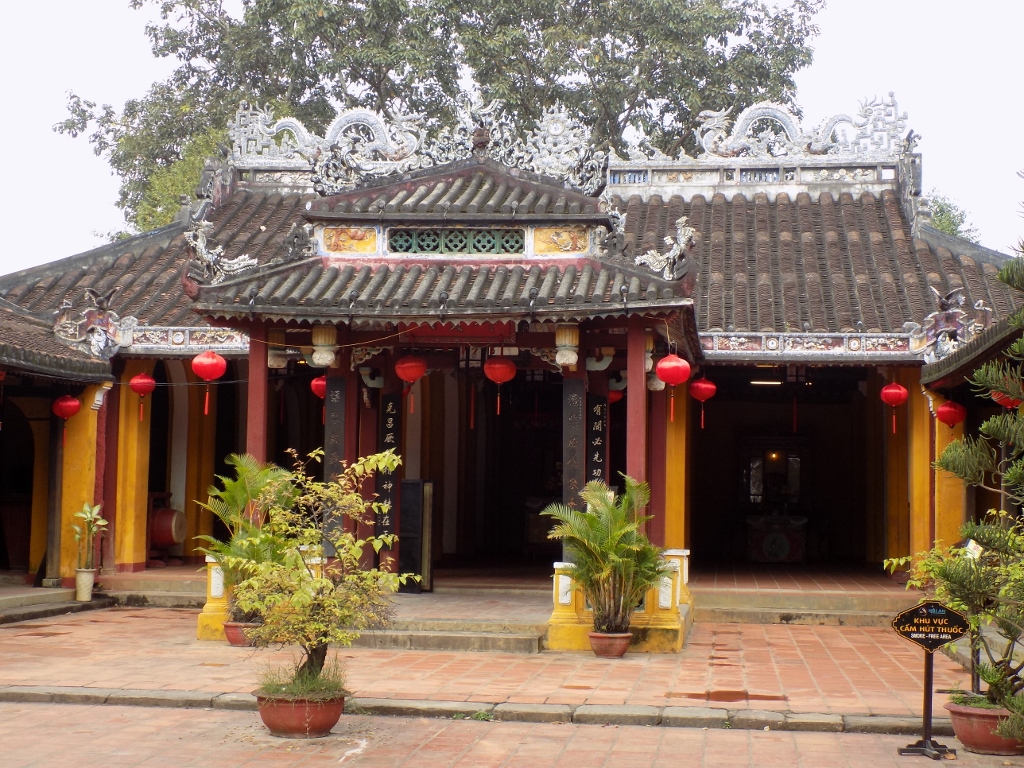 Cam Pho Communal House
Cam Pho Communal House
Namely, at the beginning of the 17th century, a large Japanese community was established in Hoi An, so they got a permit from the local rulers even to found their own settlement in which Japanese customs were respected (the same happened in the case of the Chinese local community). This house, which also serves as a temple, was significantly restored at the beginning of the 19th century, but there were some restorations done later, as well. I found particularly impressive the decorative details that could be seen on the roof of the central building.
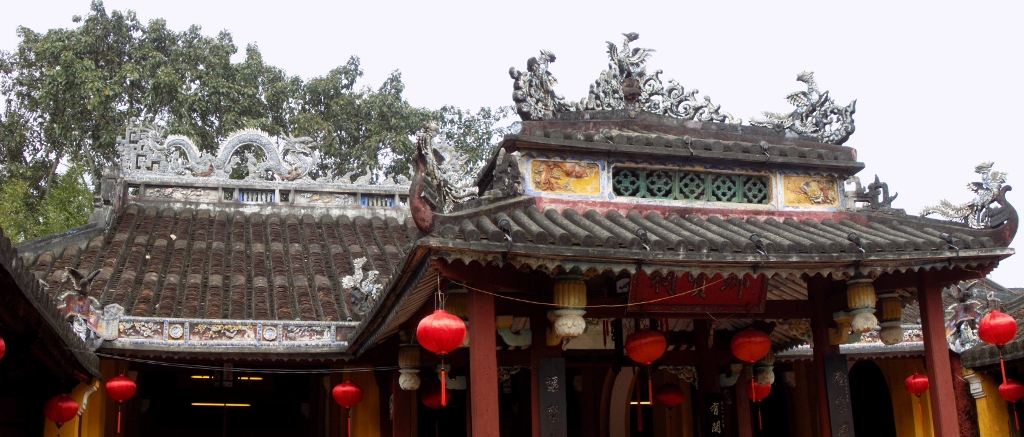 Cam Pho Communal House, the roof
Cam Pho Communal House, the roof
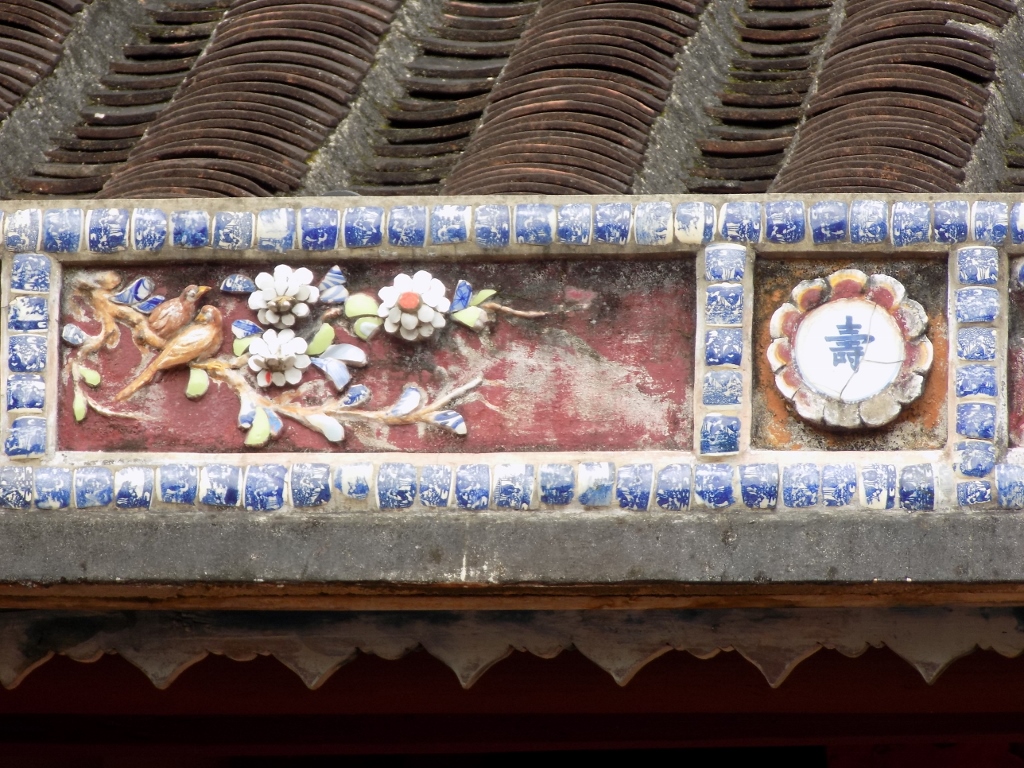 Cam Pho Communal House, a roof detail
Cam Pho Communal House, a roof detail
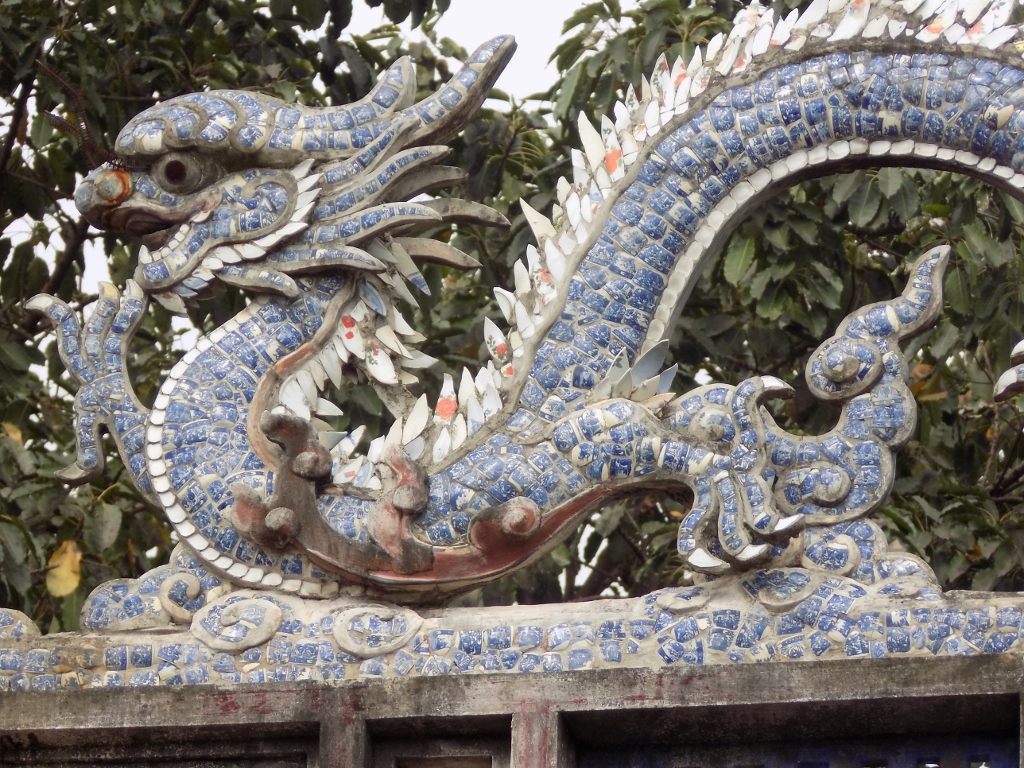 Cam Pho Communal House, a roof detail
Cam Pho Communal House, a roof detail
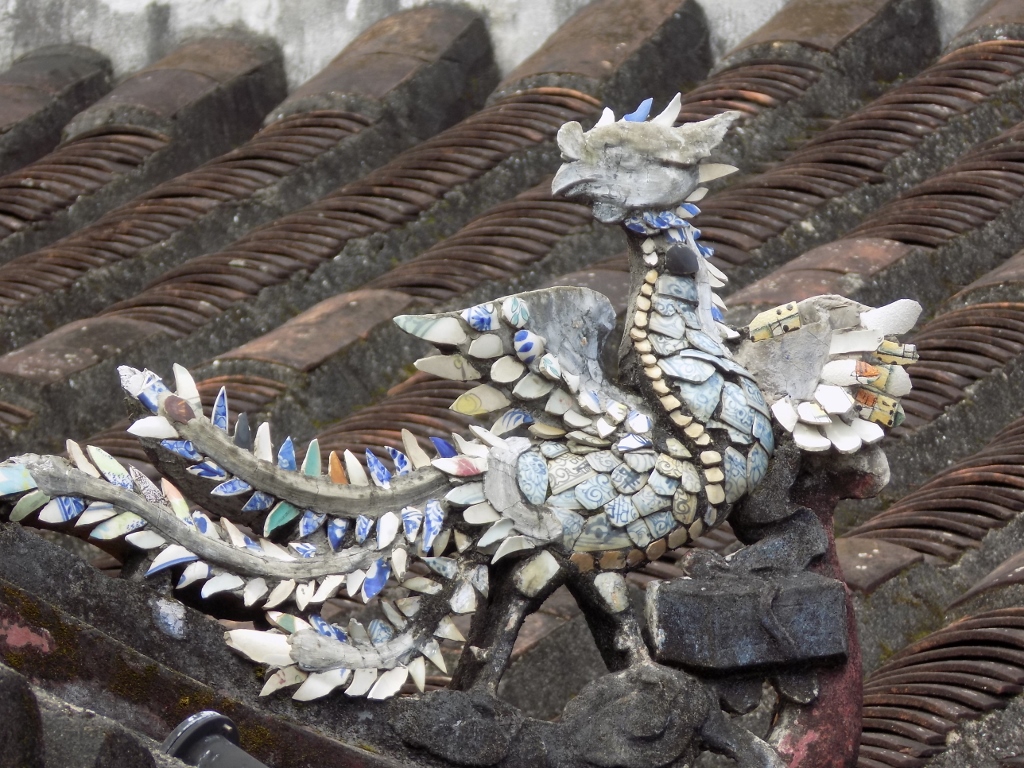 Cam Pho Communal House, a roof detail
Cam Pho Communal House, a roof detail
Between these sightseeing visits to the houses and temples, we walked along the streets of the old town of Hoi An enjoying these beautiful old houses, as well as the colourful shops and galleries. Needless to say, we ended our sightseeing by going to the Central Market where we had a great meal again.
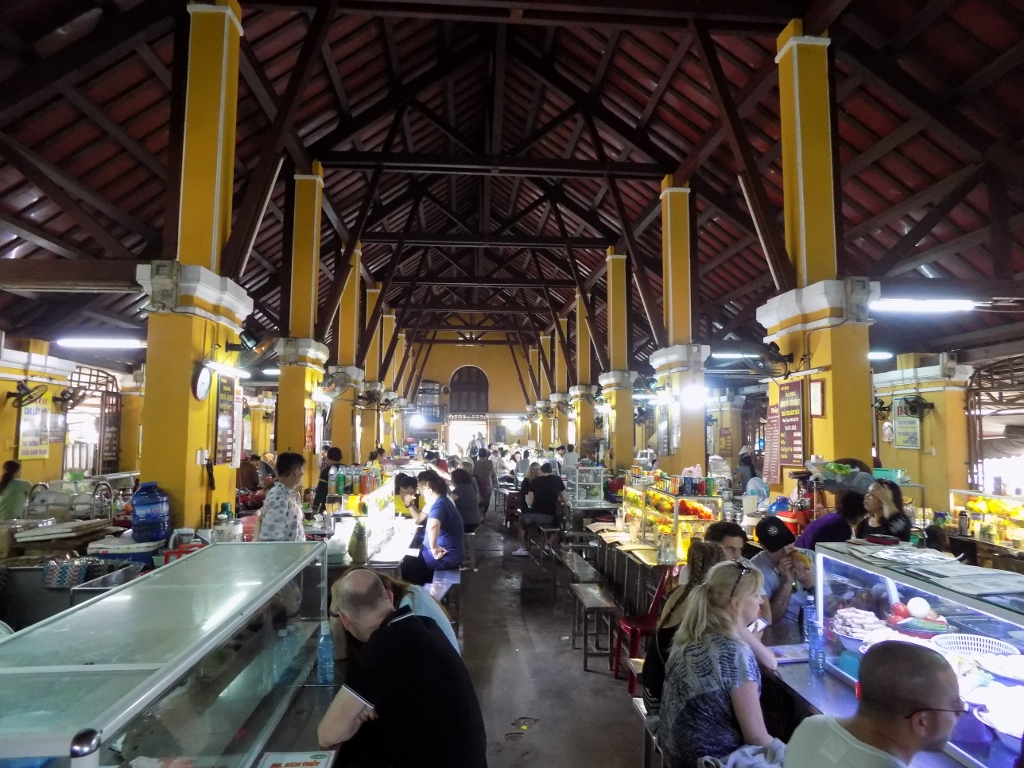 Hall of the Central Market in the old town of Hoi An with great food
Hall of the Central Market in the old town of Hoi An with great food
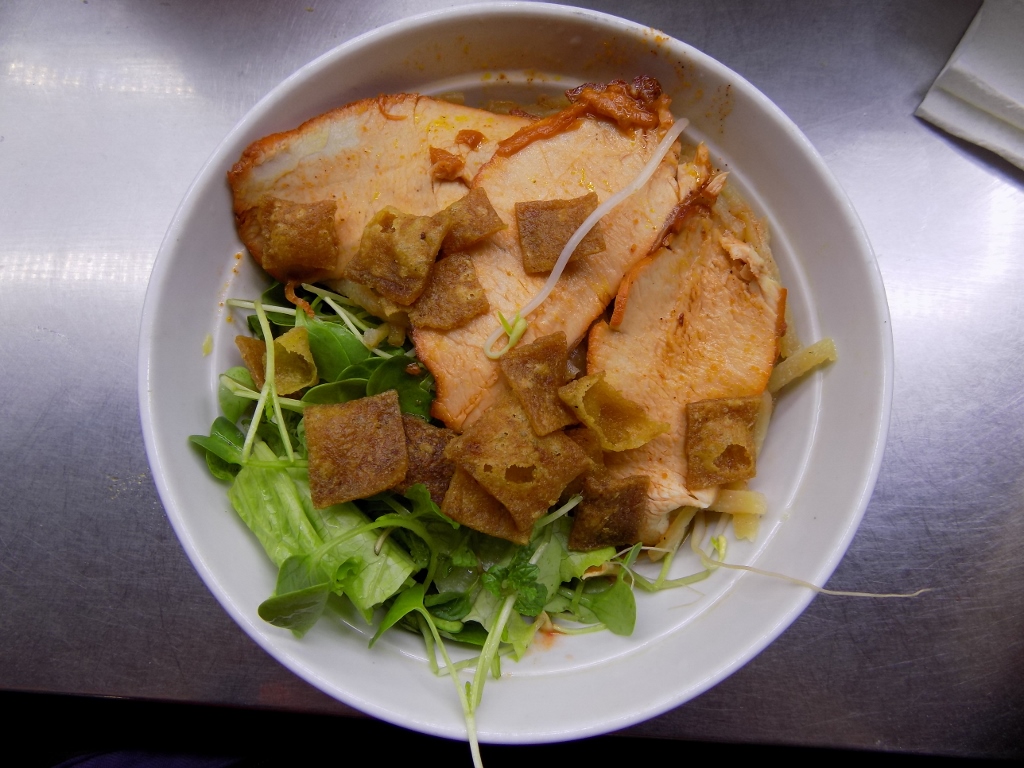 A little turf...
A little turf...
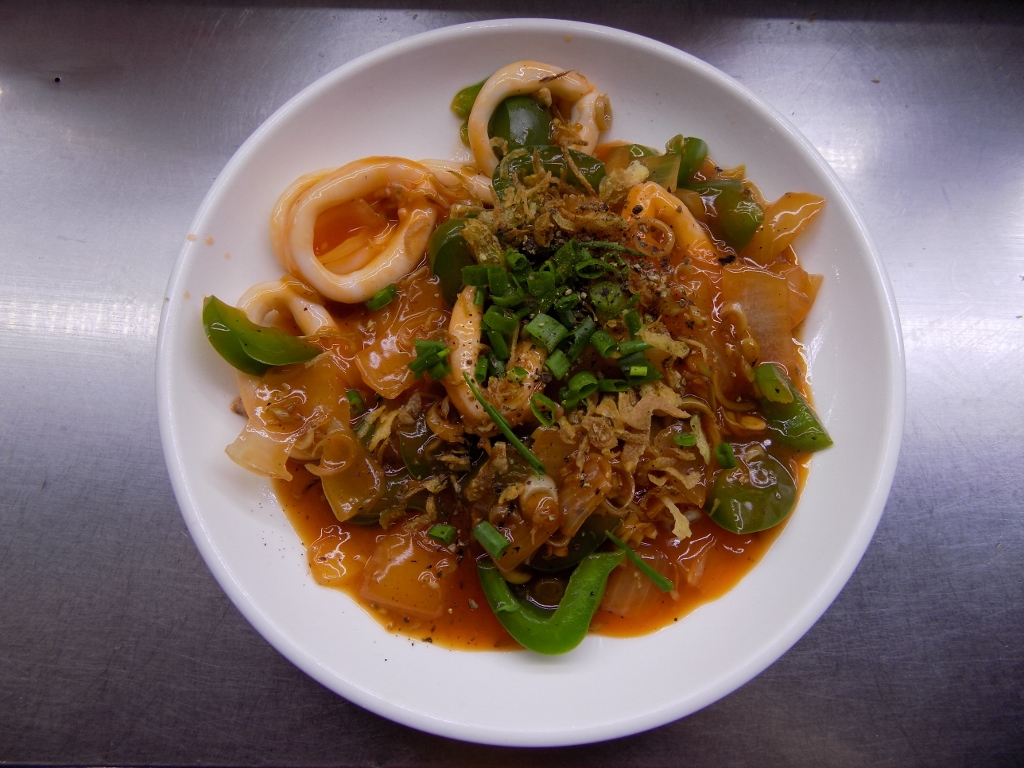 ... and a little surf
... and a little surf
After the excellent meal, we returned slowly to the hotel, had some rest in the beautiful garden and then packed up in a taxi we had arranged through the hotel to go north via the mountain that divides the country into two climate zones in order to return to Hué. When I was making the travel plan, this did make some sense. Now, on the spot, it made no sense at all, but we already had some reservations, so we stuck to the plan. It cannot all be perfect. On the other hand, we decided on this private transportation because we had concluded that it would suit us better in order not to waste too much time running after coaches, plus in this way we could stay in Hoi An longer. At one point we played with an idea to return to Hué on motorbikes, which may easily be arranged. Practically you rent motorbikes and drivers, and you sit in the back, behind the driver. The agencies renting this type of transportation also organize the separate transportation of the luggage. In addition to the adventure element, this is interesting also because it is easy to make a stop at the Hai Van Pass from where there is apparently a beautiful view at the surroundings. Of course, provided the pass is not covered in mist or clouds. Taking into account that rain was forecasted for that day, we had decided this would certainly not be the transportation of our choice bearing in mind the wet road surface.
The car transportation was primarily very comfortable and at some point the driver asked us if we wanted a break. We actually did not need any break (the trip takes less than three hours – going through the tunnel and not over the mountain), but we offered to him to make a stop any way so that he may get some rest. I don’t know if he needed a rest, but he certainly loves the noodle soup that may be bought in one local road-side place and he praised this little restaurant as the place with the best soup around. Of course, we could not resist, but we took only one soup that we shared. The clear soup was made of fish and was full of rice noodles, and with the soup we also got some small, freshly made cracklings, a few boiled quail eggs, as well as a couple of pieces of something made of meat apparently turned into a paste and cooked in banana leaves. We did find all of this very tasty, but could not help laughing at the very thought of offering something like this in some Serbian restaurant by a busy road. Back at home, such restaurants are mostly frequented by truck drivers and they love their meat – the more, the better, so there are some road-side restaurants in Serbia that are famous for their insanely huge quantities of meat per portion.
Having arrived in Hué in the evening, we had just about enough time to walk to the banks of the Perfume river (Song Huong) where we came across a night market, but relatively modest in comparison to some we had seen around Vietnam before. Returning to our hotel, we decided to change the route and then we entered a part of the city that was full of restaurants and cafés, and they were packed with people. Our hotel was actually very close to this area and yet nicely tucked away, so we could enjoy the quiet and have a nice sleep.
The next morning we took it very easy, since according to our plan we had “only” the Imperial City in Hué to visit. It is interesting that almost everybody we met during our journey, who had already been in Hoi An and Hué, praised Hoi An a great deal, saying Hué was nothing special. I was surprised by that a little, since Hué has the Imperial City which is in the UNESCO’s World Heritage Site, but I thought this was perhaps just too much ruins and then it did not seem so interesting. Hué itself, in terms of a city, is not particularly attractive, that’s true, but then again it may also be said for so many other places, Hoi An including (of course, not counting its old town).
So, thinking we had “only” one place we should be visiting that day, we started slowly, on foot, walking by the river and thus reaching the site. There we decided to buy a combined ticket which covered a visit to the Imperial City, as well as visits to three tombs located south of Hué.
At the very beginning of the 19th century, Hué became the capital of united north and south Vietnam, and this was the centre from which the Nguyen dynasty ruled. This dynasty formally remained in power until 1945, in other words, even when Vietnam was in any other realistic sense of meaning under the French rule. The dynasty ended its rule when Ho Chi Minh simply gave the last emperor a piece of paper on abdication which the latter had to sign “voluntarily.” It is interesting that this did not end the French rule though, since they did not care much about any voluntary departure from Vietnam and so the whole thing got prolonged and deteriorated to the level of war (1946-1954), when Vietnam (North Vietnam, north from the 17th parallel) officially became a completely independent republic. I’m not going to deal at all with the Vietnam War (1955-1975), here called the American War (which makes sense, since all of their wars are “Vietnam wars”), other than briefly mentioning it if it’s related to what I was visiting. Namely, so much has already been said, written, filmed and commented that there is nothing new I could possibly add on the subject.
So, soon after Emperor Gia Long had selected Hué as the capital of the united country (transferred from Hanoi), a citadel started to be built in 1804 and it was finished in 1833, while numerous additions, repairs and restorations were done over time. The citadel is huge – it is surrounded by ramparts in the shape of a square each side of which is 10 km long, while the walls are 2 metres thick. Within this space there used to be the Imperial City, also surrounded by ramparts, with a square ground plan and with 2-kilometre long sides. And within the Imperial City, there was the Purple Forbidden City that was envisaged only for the imperial family.
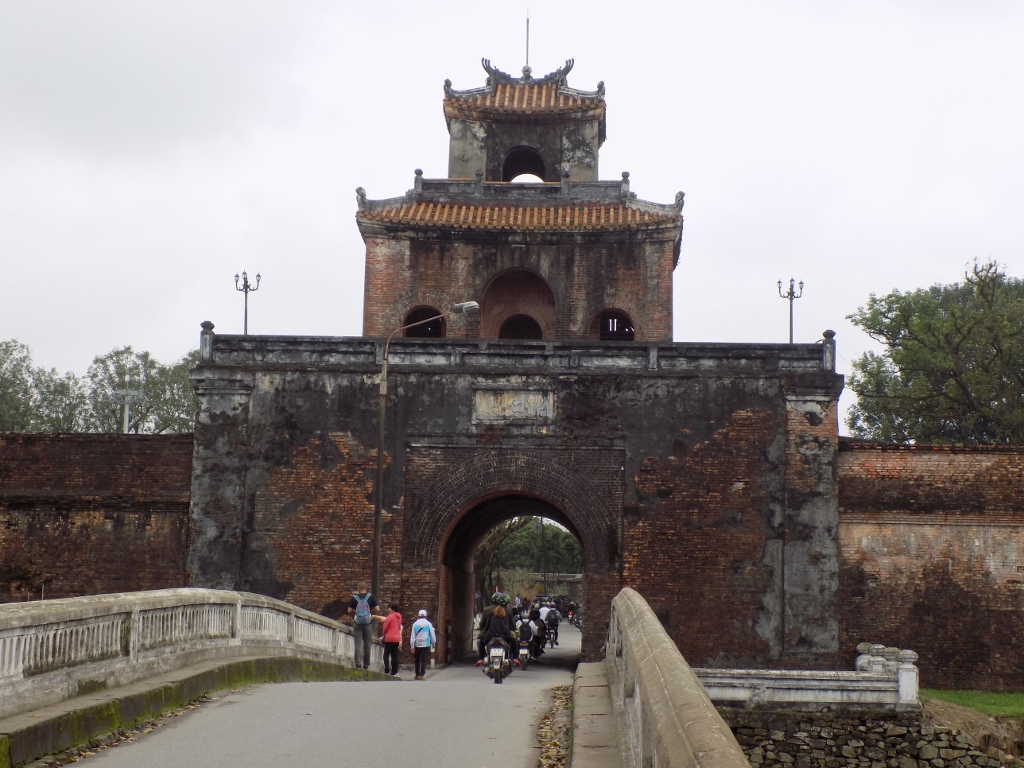 Ngan Gate, a part of the ramparts surrounding the Citadel
Ngan Gate, a part of the ramparts surrounding the Citadel
Also, around the Citadel, as well as around the Imperial City, there are moats that were filled with water from the Perfume river which provides a very easy and quick access to the sea, making the position of the capital very suitable. In addition, the location was selected because it met the complex requirements of the Phong Thuy, the Vietnamese version of the Feng Shui. Apparently, it was established that there was a “blue dragon” and a “white tiger,” all the buildings were fit not only into the natural setting, but were also built in line with the five cardinal points (centre, west, east, north, south), the five elements (earth, metal, wood, water, fire) and the five colours (yellow, white, blue, black, red). And yet, none of this realistically helped them.
Even before we reached the Citadel itself, we could see from the opposite side of the river a part of the ramparts which stands at the bank of the Perfume river like a bastion, since it holds an enormous pillar with the proud Vietnamese flag.
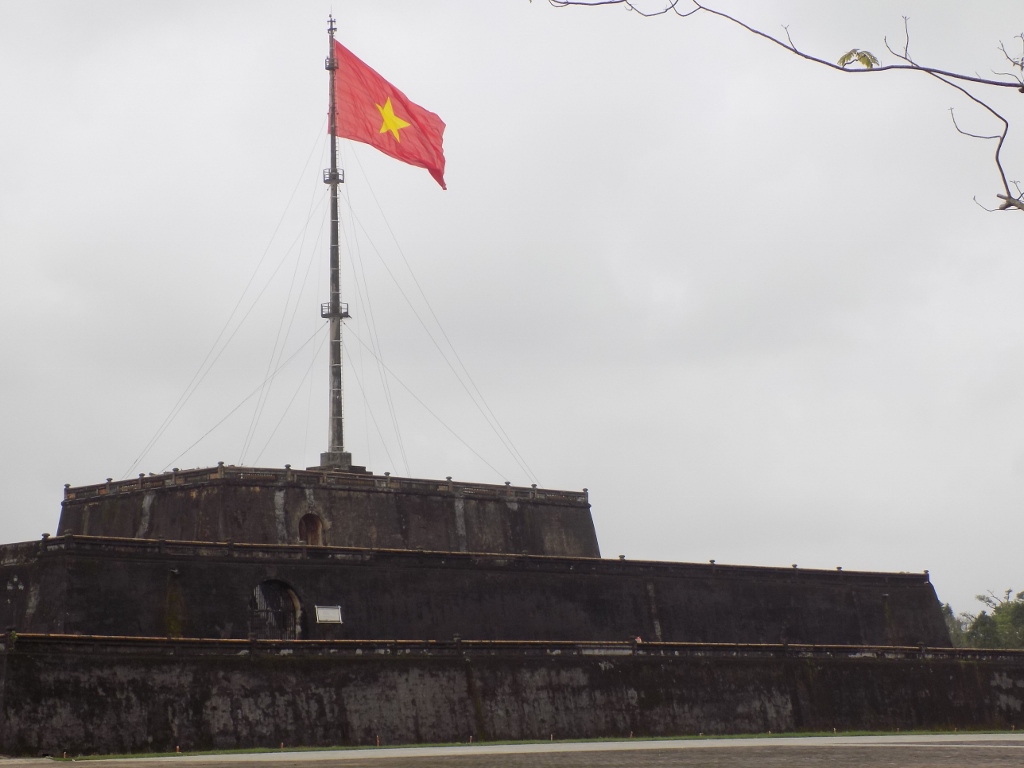 The exposed part of the Citadel’s ramparts with the Vietnamese flag
The exposed part of the Citadel’s ramparts with the Vietnamese flag
Having bought the tickets, and practically we were already within the Citadel where nowadays there are numerous streets with rushing cars, as well as a large number of houses, we approached the Ngo Mon Gate which constitutes an entrance into the Imperial City.
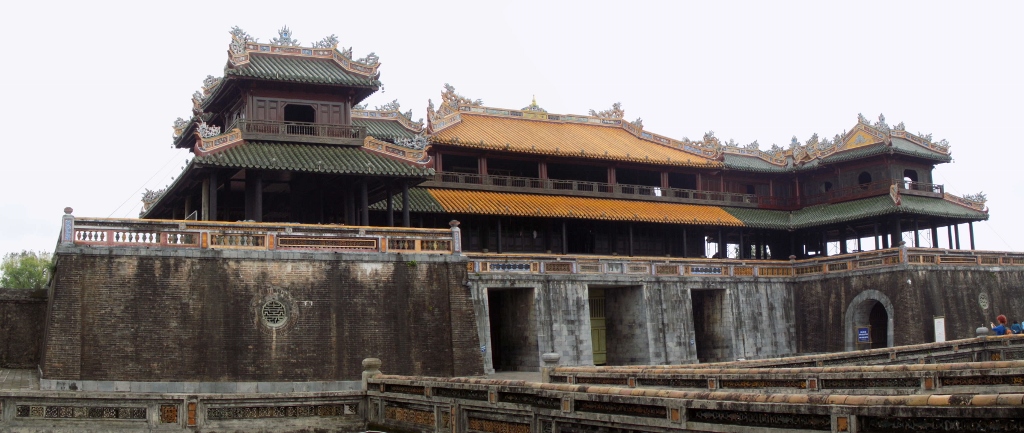 Ngo Mon Gate
Ngo Mon Gate